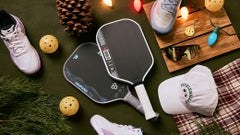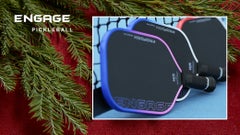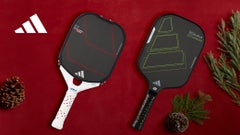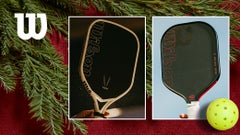How to Hit a Topspin Shot in Pickleball
To put it simply: You swing from a point behind and below the ball to a point above and ahead of the ball (or ball contact). However, that is just one part of the entire swing path, which is sandwiched in between the backswing and the follow through portion of the shot. If you want to maximize your access to topspin on your pickleball shots, read on!
Step-by-Step: How to Hit Topspin
The swing path that best produces topspin resembles the shape of a modified long C. You could also describe it as a high-to-low-to-high swing. Let’s go through the four-step process of the backswing, the drop, contact and follow through.
Step 1: Backswing (Forehand or Backhand)
Using the athletic position (slight knee bend, feet spread at shoulder width or more, weight shifted toward the toes):
- Hold the paddle in front of the body.
- Paddle tip up and around abdominal height.
Three of the more critical aspects to properly execute this process are:
- A quarter turn of your shoulders (chest more parallel to the sideline, not the net), without turning your head and while keeping eyes on the ball.
- Get your head down closer to the height of the ball, instead of standing up straight to the shot. Maintaining the athletic position inherently gets you low enough to execute most shots. A slight bend at the hips helps lean your body weight forward, but bending the knees lowers you to a proper ball striking height and allows you to transfer your weight through.
- Whether you are preparing for a forehand, a one-handed backhand or a two-handed backhand, keep both hands on the paddle during the initial part of the backswing.
Why are those three things are so important?
- The shoulder turn initiates your swing and weight transfer into the shot. Maintaining eyes on the ball (face forward), throughout the entire shot process is key. Turning your head with the shoulder turn (even a little) eliminates the benefit of binocular vision as you now have just one eye on the ball!
- Shots are easier to judge and execute when your eyes are closer to the level of the shot. When you are lower to the ball, it is also easier to transfer your body weight toward your target.
- Both hands on the paddle during the shoulder turn ensures that you are properly positioned to the shot you are going to hit.
Step 2: The Drop
This is where the paddle begins its drop from the high backswing position. From there you can take advantage of gravity by dropping the paddle to the bottom of your swing like the curve of an exaggerated C. How low you drop the paddle depends on the expected height of ball contact, along with how much spin you are adding to the shot. In general you want the lowest part of the swing to be a couple of inches beneath the contact point.
Step 3: Ball Contact
The drop of the paddle merges into the “just before and after” ball contact portion. This is also the “aim and accelerate” part of the swing. Once you are past the bottom turn of the swing, using a relaxed grip (eastern or continental), you then increase paddle speed. Like a racecar going through a corner, you accelerate out of it (not into it) to get the best result.
Step 4: The Follow Through
At this point of the swing the ball is either just exiting or has just exited the paddle face. Just because the follow through is at the tail end of the process that does not mean you can let go of your focus. While continuing to accelerate the paddle and finishing high out and through the ball, you want to stay low. This is also the part of the swing where the player decides how steep or shallow the incline of their swing path is. Paddle speed and the degree of incline to your swing path determines the ratio of ball topspin versus shot speed.
If the swing speeds are the same:
- A steeper incline to your swing path will potentially produce more spin.
- A less steep swing path potentially produces more speed.
Other Variables to Consider
The angle of your paddle face also plays a major role in terms of the type of shot that is produced. For topspin, the paddle face and swing direction need to be closely aligned. If the angle of the paddle face and the direction of the swing are precisely the same, the ball will just clip off the edge of the paddle. So it becomes a matter of figuring out how little or how much the paddle face needs to be open relative to the direction of the swing.
If the angle of the paddle face opposes the direction of the swing you will make ball contact on the paddle face but without generating much spin.
How open should the paddle face be? This is where a paddle with a high friction surface presents an advantage. If the paddle surface is gritty, you do not have to open the paddle face much to grip the ball and develop both spin and speed on the ball. If the paddle surface lacks friction, the player must open the paddle face more and maybe switch to a more linear swing path to make up for its slicker surface.
In Conclusion
Spin has changed pickleball for the better. There must be an advantage because there is a limit to how much friction paddle surfaces are allowed to exhibit. Topspin in particular allows players to hit the ball with more pace and accuracy. So long as you add enough topspin you can hit the ball as hard as you like, and the shot will drop down inside the lines.








